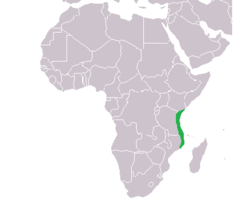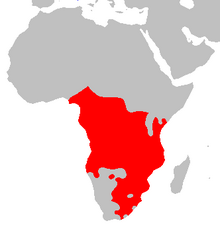
Back زنج Arabic Zəncilər Azerbaijani Zanj Catalan زەنگ (ناوچە) CKB Zandsch German Zanj Spanish زنگ (منطقه) Persian Zenj French Zanj ID Zanj Italian


Zanj (Arabic: زَنْج, adj. زنجي, Zanjī; from Persian: زنگ, romanized: Zang)[1][2] is a term used by medieval Muslim geographers to refer to both a certain portion of Southeast Africa (primarily the Swahili Coast) and to its Bantu inhabitants.[3] It has also been used to refer to East Africans collectively by Arab sources.[4]: 613 This word is also the origin of the place-names Zanzibar ("coast of the Zanji") and the Sea of Zanj.
The latinization Zingium serves as an archaic name for the coastal area in modern Kenya and Tanzania in southern East Africa. The architecture of these commercial urban settlements is now a subject of study for urban planning.[5][6] For centuries the coastal settlements were a source of ivory, gold, and slaves, from sections of the conquered hinterland, to the Indian Ocean world.[7]
- ^ El-Azhari, Taef (2016). Zengi and the Muslim Response to the Crusades: The Politics of Jihad. Routledge. p. 20. ISBN 978-1317589396. Retrieved 3 January 2017.
- ^ Ḵẖān, M. S. (1981). "Al-Masʿūdī and the Geography of India". Zeitschrift der Deutschen Morgenländischen Gesellschaft. 131 (1): 119–136 [p. 130]. JSTOR 43376756.
- ^ Cite error: The named reference
Bagleywas invoked but never defined (see the help page). - ^ Masao, Fidelis; Mutoro, Henry (1988). "The East African coast and the Comoro Islands". General History of Africa: Volume 3. UNESCO Publishing.
- ^ Cite error: The named reference
Nezar AlSayyadwas invoked but never defined (see the help page). - ^ Pollard, E.; Fleisher, J.; Wynne-Jones, S. (2012). "Beyond the Stone Town: Maritime Architecture at Fourteenth–Fifteenth Century Songo Mnara, Tanzania". Journal of Maritime Archaeology. 7 (1): 43–62. Bibcode:2012JMarA...7...43P. doi:10.1007/s11457-012-9094-9. S2CID 162935843.
- ^ Cite error: The named reference
Oliverwas invoked but never defined (see the help page).